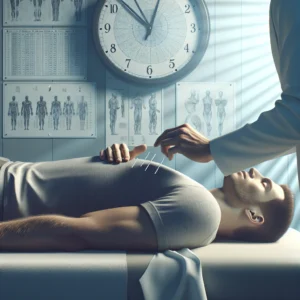Exploring the Benefits of Acupuncture for Managing Restless Leg Syndrome
Many individuals are turning to holistic therapies in their quest for wellness, and Acupuncture stands out as a promising method for alleviating the discomfort associated with restless leg syndrome (RLS). This ancient practice, deeply embedded in the principles of Traditional Chinese Medicine, has garnered attention from those seeking relief from the distressing sensations that define RLS. In this discussion, we will explore the intricate details of RLS, the mechanisms by which acupuncture operates, and the compelling clinical research that substantiates its effectiveness.
Identifying Symptoms and Causes of Restless Leg Syndrome
Restless leg syndrome manifests as an uncontrollable urge to move one's legs, often accompanied by discomforting sensations such as crawling, tingling, or aching. These sensations intensify during inactivity, particularly at night, resulting in significant disruptions to sleep patterns. For many individuals, this creates a debilitating cycle of fatigue and irritability, negatively impacting their overall quality of life and emotional well-being.
While the exact origins of RLS remain somewhat elusive, research indicates that genetic predisposition may play a significant role. Factors contributing to RLS can include iron deficiency, certain chronic health conditions, and pregnancy. Grasping these complexities is essential for effective treatment strategies. Furthermore, disruptions in dopamine pathways in the brain, which are crucial for regulating movement, have been associated with this condition.
Utilising acupuncture may offer a promising avenue for relief. It effectively targets the symptoms and potential underlying causes, thus helping restore the body's natural balance.
Unveiling the Mechanisms of Acupuncture: How It Provides Relief
The foundational principle of acupuncture revolves around harmonising the body's energy, known as “Qi.” This time-honored practice involves placing thin needles at specific points along the body's meridians, which can stimulate the nervous system, enhance blood circulation, and promote the release of endorphins—natural pain-relieving compounds produced by the body. This multifaceted strategy can effectively mitigate the discomfort linked to RLS.
From a scientific lens, acupuncture is believed to influence neurotransmitter levels, including dopamine, which is frequently implicated in the pathophysiology of RLS. By restoring the normal functioning of the nervous system, acupuncture alleviates the unpleasant sensations and fosters a sense of relaxation and overall well-being. Many patients report experiencing a reduction in symptoms after just a handful of sessions, emphasising the potential of acupuncture as either a primary or complementary treatment strategy for RLS.
Exploring Clinical Evidence: Research Supporting Acupuncture for RLS Management
Recent studies have shed light on the effectiveness of acupuncture for restless leg syndrome. Numerous clinical trials have shown that patients experience noteworthy reductions in RLS symptoms following acupuncture interventions. One prominent study published in a respected medical journal indicated that individuals receiving acupuncture reported substantial improvements in the frequency and severity of their symptoms compared to placebo groups.
Additionally, meta-analyses have indicated that acupuncture yields more pronounced results when combined with lifestyle alterations, such as making dietary adjustments and engaging in regular physical activity. These findings highlight the significance of a holistic approach in managing RLS, reinforcing that acupuncture can serve as a vital resource within a comprehensive treatment framework.
By integrating ancient wisdom and contemporary scientific understanding, we can appreciate acupuncture's role as a formidable ally in managing restless leg syndrome. By comprehensively understanding the symptoms, mechanisms, and clinical validation, individuals can make well-informed choices regarding their therapeutic options.
What to Expect During Your Acupuncture Journey: Preparation Tips

Embarking on the path of acupuncture for RLS can initially seem intimidating, but proper preparation can significantly enhance the effectiveness and satisfaction of your experience. Understanding what to anticipate can help alleviate any apprehensions and optimise the therapeutic outcomes of your treatment.
Finding the Right Acupuncturist: Key Qualifications and Areas of Specialisation
Selecting the appropriate acupuncturist is a crucial step toward achieving relief from RLS. Seek practitioners with a degree from an accredited institution and a valid license to practice in your area. Additionally, finding someone specialising in treating restless leg syndrome or similar conditions can be incredibly beneficial.
It's advisable to schedule consultations or interviews with potential acupuncturists. During these discussions, inquire about their experience specifically related to RLS and their treatment methods. A skilled acupuncturist will take the time to understand your unique symptoms and develop a personalised treatment plan tailored to your specific needs.
Beyond educational credentials, trust your instincts. The therapeutic relationship between the acupuncturist and patient is fundamental; feeling comfortable and understood can significantly enhance the effectiveness of your treatments.
Pre-Session Preparations: Essential Steps to Take Before Your Appointment
Several preparatory steps can help you maximise the advantages of your acupuncture session. Firstly, it's important to arrive well-hydrated for your appointment but avoid heavy meals right before the session. A light snack can help maintain energy levels without causing discomfort during treatment.
Consider keeping a detailed record of your symptoms. Documenting your experiences with RLS can provide invaluable insights for your acupuncturist, enabling them to customise your treatment effectively. Be prepared to discuss any medications or supplements you are currently taking, as these can influence your treatment plan.
Additionally, opt for loose, comfortable clothing that allows easy access to the acupuncture points on your legs. This ensures that your experience is as pleasant and effective as possible.
A Detailed Guide to Your Acupuncture Session: What Happens During Treatment

Understanding the flow of an acupuncture session can help demystify the experience. Upon arrival, your acupuncturist will comprehensively evaluate your symptoms and medical history. This thorough intake process lays the groundwork for your personalised treatment plan.
Once in the treatment area, you will recline in a comfortable position. The acupuncturist will then insert thin needles into specific points on your body, often concentrating on areas related to your legs and overall relaxation. Most patients report minimal sensation during needle insertion, describing it as a slight prick or gentle tingling.
Following the needle insertion, you will remain still for approximately 20 to 30 minutes. Many individuals find themselves enveloped in a profound sense of tranquility during this time. Some patients even drift into a light sleep as their bodies release tension and restore internal balance.
At the conclusion of your session, the acupuncturist will carefully remove the needles and may offer recommendations for post-session care, which can further enhance the treatment's benefits. By following these steps, you can ensure that you are well-prepared for your acupuncture experience, setting the stage for effectively managing your restless leg syndrome symptoms.
Targeted Acupuncture Techniques to Alleviate Restless Leg Syndrome Symptoms
The practice of acupuncture is not uniform; various techniques and strategies can be employed to address the distinctive symptoms of RLS specifically. Understanding these methods empowers patients in their pursuit of relief.
Effective Acupoints for Relieving RLS Symptoms: Key Locations and Their Functions
Specific acupoints have been identified as particularly effective in alleviating the symptoms associated with restless leg syndrome. Among the most commonly utilised points are:
– LI4 (Hegu): This point, located on the hand, is renowned for relieving pain and promoting relaxation.
– SP6 (Sanyinjiao): Situated on the inner leg, this acupoint frequently addresses leg-related concerns and effectively calms the nervous system.
– KD3 (Taixi): Found on the inside of the ankle, this point is linked to kidney health and overall vitality.
In addition to these specific points, acupuncturists may incorporate distal points to enhance overall circulation and wellness. The precise combination of acupoints can vary based on individual symptoms, emphasising the importance of collaboration with a trained professional.
 Establishing Frequency and Duration: Crafting the Optimal Treatment Plan
Establishing Frequency and Duration: Crafting the Optimal Treatment Plan
Determining the frequency and duration of acupuncture treatments for RLS can significantly influence the results. Many practitioners recommend starting with one to two weekly sessions for the first month. This frequency allows the body to adjust to the treatment and can lead to more noticeable symptom relief.
As symptoms stabilise, the treatment plan may evolve to sessions every two weeks or monthly maintenance appointments. Open communication with your acupuncturist is essential to adjust the treatment plan as needed based on your progress and any changes in symptoms.
Typically, each session lasts 30 to 60 minutes, with some individuals requiring longer appointments to address more complex issues. Patience is key; acupuncture is a gradual process, and consistent treatment often yields the most favorable outcomes.
Integrating Acupuncture with Other Therapeutic Approaches: A Comprehensive Strategy
While acupuncture can be a potent therapeutic option, its effectiveness is frequently amplified with complementary treatment modalities. A comprehensive approach may encompass lifestyle adjustments, nutritional modifications, and physical therapies.
For example, incorporating gentle stretching or yoga can enhance overall leg circulation and flexibility, thereby complementing the effects of acupuncture. Focusing on nutritional support, especially iron-rich foods, can help address deficiencies contributing to RLS symptoms.
Furthermore, cognitive behavioral therapy (CBT) can be beneficial for individuals dealing with anxiety or stress related to their RLS symptoms. This integrative approach can form a well-rounded treatment plan that addresses restless leg syndrome's physical and psychological dimensions, paving the way for lasting relief.
Real-Life Experiences: Personal Stories of Success with Acupuncture for RLS
Personal narratives often illuminate the transformative potential of acupuncture for RLS. These stories demonstrate the effectiveness of treatment and offer hope and inspiration to those facing this challenging condition.
Case Study 1: Transforming Sleepless Nights into Restful Sleep
Meet Sarah, a 45-year-old mother of two who battled RLS for over a decade. Her nights were plagued by discomfort, leaving her fatigued and irritable during the day. After researching acupuncture for restless leg syndrome, Sarah gave it a chance.
Her initial sessions were eye-opening. The acupuncturist focused on critical points in her legs and lower back, and Sarah began to embrace the calming rituals associated with treatment. Over the subsequent weeks, she noticed a remarkable decrease in her RLS symptoms. For the first time in years, she experienced uninterrupted sleep, dramatically enhancing her daily life.
Sarah's journey highlights the significant impact acupuncture can have on individuals living with RLS, offering hope where previously there seemed to be little.
Case Study 2: Alleviating RLS Symptoms During Pregnancy
Pregnancy can present numerous challenges, and for Emily, it also meant confronting RLS. As she approached her third trimester, the discomfort escalated, leaving her restless and anxious. Seeking relief, Emily turned to acupuncture.
Her acupuncturist crafted a treatment plan focused on safe points suitable for pregnancy. After just a few sessions, Emily experienced a significant improvement. The soothing effects of acupuncture not only alleviated her RLS symptoms but also fostered relaxation, making her pregnancy journey far more enjoyable.
This experience illustrates the versatility of acupuncture in addressing RLS at various life stages, showcasing its potential as a supportive therapy during pregnancy.
Case Study 3: Long-Term Management Strategies for RLS
For Mark, a 55-year-old man, living with RLS had become a chronic struggle. After years of trialing various medications with limited success, he discovered acupuncture. Initially skeptical, he approached his first session with an open mind.
Over the following months, Mark committed to a consistent acupuncture regimen. Each session alleviated his RLS symptoms and enhanced his overall health and well-being. Mark learned the importance of maintaining a regular schedule and integrating acupuncture into his long-term management strategy.
As a result, Mark now enjoys a significantly improved quality of life, with reduced symptoms. His story underscores how acupuncture can be a central component of long-term RLS management.
 Addressing Common Questions and Concerns About Acupuncture for RLS
Addressing Common Questions and Concerns About Acupuncture for RLS
Individuals contemplating acupuncture for RLS may have questions or concerns as with any therapeutic approach. Addressing these inquiries can help demystify the treatment process and empower patients to make informed choices.
Are There Side Effects Associated with Acupuncture for RLS?
While acupuncture is generally recognised as safe when performed by a qualified practitioner, some individuals might experience mild side effects, such as bruising at the needle insertion sites or transient fatigue. These effects are typically short-lived. To minimise any potential risks, it is critical to communicate openly with your acupuncturist regarding your health history and any concerns you might have.
Can Acupuncture Provide Permanent Relief from RLS?
The potential for acupuncture to offer long-lasting or permanent relief from RLS varies from person to person. While many individuals experience significant reductions in symptoms, RLS is often a chronic condition that may necessitate ongoing management. Acupuncture can be vital in a comprehensive treatment strategy but may not serve as a standalone cure.
Does Insurance cover Acupuncture for RLS Treatment?
Insurance coverage for acupuncture can vary widely. Many insurance plans provide partial or complete coverage for acupuncture when utilised for specific conditions, including restless leg syndrome. It is advisable to check with your insurance provider to clarify your coverage options and any necessary documentation for reimbursement.
How Many Acupuncture Sessions Are Typically Required for Relief?
The number of acupuncture sessions needed to relieve RLS symptoms can differ significantly among individuals. Many practitioners recommend an initial series of 6-10 sessions over a few weeks to evaluate effectiveness, followed by a maintenance schedule tailored to individual requirements.
Is It Possible to Combine Acupuncture with Other Treatments?
Acupuncture can be effectively combined with other treatment modalities for RLS, such as lifestyle changes, dietary adjustments, and even medications. This holistic approach often leads to improved outcomes, addressing various aspects of the condition.
What Should I Do If I Don't Notice Any Improvement?
If you do not observe noticeable improvement after several sessions, it is essential to communicate your concerns with your acupuncturist. They may adjust your treatment plan or explore additional therapeutic options to address your symptoms better.
Is Acupuncture Painful?
Most patients report minimal discomfort during acupuncture sessions. The needles used are skinny, and the sensation is often described as a mild prick or gentle tingling. Many individuals find the overall experience relaxing and rejuvenating.
How Can I Find a Qualified Acupuncturist?
To locate a qualified acupuncturist, seek recommendations from healthcare providers, friends, or online directories. Look for practitioners with relevant credentials and experience in treating restless leg syndrome.
What Lifestyle Changes Can Enhance the Benefits of Acupuncture?
Incorporating regular physical activity, maintaining a balanced diet rich in iron, and practicing relaxation techniques can amplify the benefits of acupuncture for RLS. Adhering to a consistent sleep schedule can also contribute positively.
Are There Any Contraindications for Acupuncture?
While acupuncture is generally safe for most individuals, certain conditions, such as bleeding disorders or active infections, may necessitate caution. It is always best to consult your healthcare provider before beginning acupuncture to ensure it aligns with your overall health plan.



























12 Comments
I found your exploration of acupuncture as a treatment for restless leg syndrome intriguing, especially as someone who has struggled with RLS myself. The symptoms you described—like the crawling and tingling sensations—can significantly disrupt not only sleep but also daily activities, making the search for effective relief quite critical.
I appreciate this exploration of acupuncture and its potential benefits for managing restless leg syndrome (RLS). Having dealt with RLS myself, I can attest to how disruptive those sensations can be, especially when trying to fall asleep. While I initially sought out more conventional treatments, I’ve since become curious about non-traditional methods like acupuncture.
The exploration of acupuncture as a potential remedy for restless leg syndrome presents an intriguing intersection of ancient practices and modern health challenges. I’ve personally found that the holistic approach of acupuncture not only addresses physical symptoms but can also have a calming effect on mental well-being. It’s fascinating how the mind-body connection plays such a crucial role in managing conditions like RLS.
Your exploration of acupuncture as a therapeutic approach for managing restless leg syndrome (RLS) sheds light on an often-overlooked aspect of wellness that resonates deeply with many individuals facing this challenge. RLS, with its myriad of uncomfortable sensations, can severely disrupt not only sleep but also overall quality of life. It is fascinating how the principles of Traditional Chinese Medicine, which emphasize balance and harmony within the body, can offer a fresh perspective on conditions that Western medicine often approaches with pharmaceuticals.
Your exploration of acupuncture for managing restless leg syndrome (RLS) resonates deeply, especially in a world increasingly leaning toward holistic therapies. As someone who has personally navigated the winding path of managing chronic conditions, I find the potential of acupuncture particularly intriguing.
Your experience navigating chronic conditions really adds so much depth to this conversation about acupuncture and RLS. It’s fascinating how holistic therapies are gaining traction as people look for alternatives beyond traditional medicine. I appreciate how acupuncture not only addresses symptoms but also considers the body’s overall balance.
It’s fascinating to see acupuncture gaining recognition for its potential benefits in managing restless leg syndrome! I’ve personally witnessed how holistic approaches can transform one’s health journey. A close friend of mine struggled with RLS for years and after trying various remedies, she finally found relief through acupuncture and mindfulness practices. The combination not only eased her physical discomfort but also helped her reconnect with her body in a profound way.
While I appreciate the emphasis on holistic therapies like acupuncture for managing restless leg syndrome (RLS), I find it crucial to explore the complexities of this condition further. Many individuals may find temporary relief through acupuncture, but the underlying causes of RLS often relate to neurological or vascular issues, which acupuncture alone may not address.
This post raises such vital points about the intersection of holistic therapies and modern health challenges. I’ve had my own encounters with restless leg syndrome (RLS), and it can be incredibly frustrating—especially when you’re trying to wind down for the night after a long day. The sensation can feel both mysterious and deeply distressing, often leaving you feeling helpless at a time when all you want is rest.
Your experience with restless leg syndrome (RLS) really resonates. It’s tough to navigate the evening hours when all you’re aiming for is relaxation, yet your legs have other plans. That internal conflict can be exhausting, especially when the world around you begins to quiet down. It’s not just a physical sensation; it can bring in a whole wave of anxiety and frustration when you’re longing for peace.
I really appreciate your insights on acupuncture for managing restless leg syndrome. RLS is such a challenge for so many people, and it can be frustrating to find effective relief. I’ve heard from friends who have struggled with it and often resorted to medications that come with a slew of side effects, so it’s refreshing to see more people considering holistic approaches.
The exploration of acupuncture’s role in managing Restless Leg Syndrome is particularly intriguing, especially as more people seek natural alternatives to conventional treatments. Personally, I have seen how acupuncture can create a noticeable difference in overall well-being, not just in reducing discomfort. Aligning with Traditional Chinese Medicine, acupuncture seems to address not only the symptoms but also the underlying imbalances in energy that may contribute to RLS.